
The next-generation 2023 Ford Ranger should be hitting showrooms in a few short weeks, and Ford Australia has managed a calculated drip feed of information about the new cars for the past year.
While the official release date is in June, we got our first chance to get up close to Ford’s new truck back in November 2021 when we were given access to a prototype vehicle and the engineers behind them.
Joining us at Ford’s secretive You Yangs Proving Ground near Geelong, Victoria, were Pritika Maharaj, Ranger and Everest program manager, and Ian Foston, chief engineer for the T6 platform on which the Ranger, Everest and Bronco are built.
UPDATE, July 2022: New Ford Ranger review – it's here at last
The new 2023 Ford Ranger is now on sale in Australia, and the local media launch has been run. The Wheels and 4x4 Australia teams have both driven the new Ranger, and you can find their stories at the links below.
Story continues...

The vehicles at hand are known as TT prototypes. That is, they are the first vehicles to come off the production line in Thailand as opposed to the earlier prototypes that are hand-built at Ford Australia’s Broadmeadows facility. As well as the two factories in Thailand where the Australian production cars will come from, the new Ranger will also be built in North America, South America and South Africa.
The cars were still heavily camouflaged for this drive, as this was happening well before Ford unveiled the look of the car and before we knew any specifications of the drivetrains and their outputs. Of course, we now know what they look like and what will be powering them.
While still a strong suspicion at this time, we were pleasantly surprised to find the cars we would be driving were powered by the V6 diesel engine. While Ford couldn’t give us the details at the time, we now know the 3.0-litre V6 puts out 184kW at 3250rpm and 600Nm from 1750 to 2250rpm.
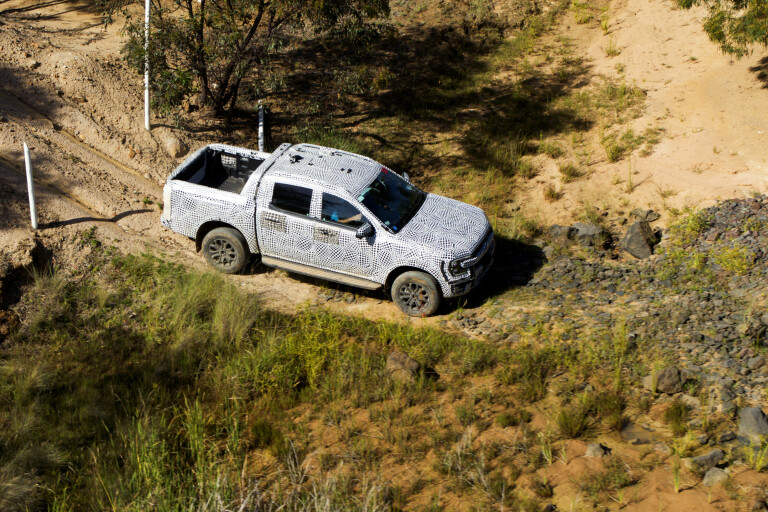
The V6 engine is from the ‘Lion’ family of engines, which relate back to the 2.7-litre version we remember from the Land Rover Discovery 3 and Ford Territory, while the latter 3.0-litre version was used in other Land Rover models and most recently in the Ford F-150 for a short time.
“The 3.0-litre V6 turbo-diesel delivers,” said Pritika. “When you drive a Ranger with the V6 turbo-diesel, it feels like a much bigger truck. And it feels strong in the sense that it’s got plenty of power and torque, which is exactly what our customers told us they wanted.”
On track
Our first drive was on a twisting sealed road circuit designed to display the car’s performance and dynamics, but before we drove the prototypes, we first did it in a current model Wildtrak with the 2.0 bi-turbo engine and 10-speed auto.
With Pritika riding shotgun, I was pleased when the Ranger displayed the transmission hesitancy and uncertainty as we left the line and I commented that I hoped they were able to fix that. “You’ll see,” was her knowing reply.

The 10R60 transmission has undergone a considerable makeover since it appeared in the Ranger behind the 2.0 diesel, and it is also used in the Mustang, F Trucks and other Ford Global products. For the next-gen Ranger, it gets a new torque converter and closer gear ratios to make it more refined and responsive behind both the TDV6 and the in-line four-cylinder diesel engines.
In the next-gen prototype, I left the line just as I had in the previous model and it showed no sign of hesitancy or indecision – a positive first impression of the new car. The power of the engine is immediately evident, leaving me thinking that this is what 4x4 ute owners want. The current model VW Amarok is the only car that would come close in drivetrain performance.
With its longer and higher bonnet, the new Ranger feels like a bigger car from behind the wheel, even though the overall dimensions are similar. This, in line with Pritika’s comments about the drivetrain, gives the car an all-new feeling. It is more planted on the road through the bends largely due to its 50mm wider wheeltrack.
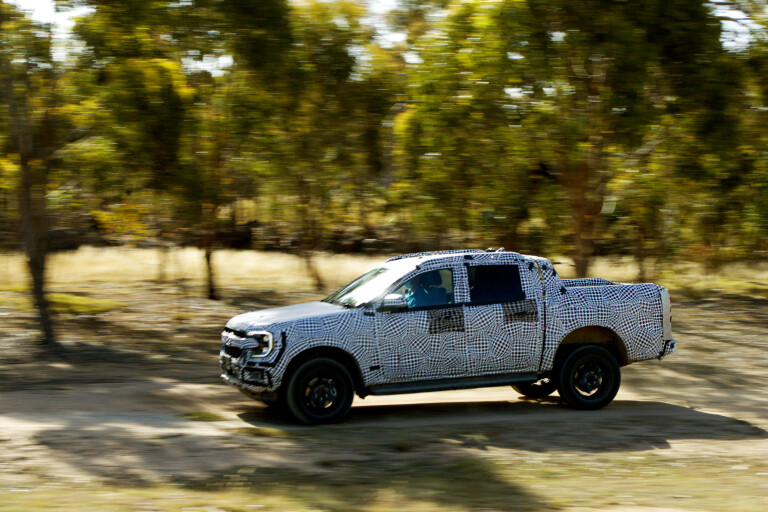
A huge revelation came on a section of the track where high-frequency humps in the road upset the chassis in the current model car and kicked it off line, following the camber of the road. Driving the TT prototype over the same section and taken at the same speed, no such instability was evident and it tracked straight across the bumps.
Even though this was a sealed road, this section was similar to corrugations you find on outback gravel roads, so it will be interesting to get one of the production Rangers out bush.
While only a short drive, it did reveal the new Ranger to have a more stable and surefooted chassis, with a powertrain that should meet the needs of buyers be it for performance, towing or off-roading.
Off-road
We took the TT prototype and current model Rangers to an off-road loop within the proving ground that included steep climbs and descents, side-slopes, cross-axle articulation, rocks and sand.
This time we had Ian Foston riding shotgun and again we first drove the current model car around the course. We’re only too familiar with the PX Ranger and its abilities and, as expected, the car did it all relatively easily. The Ranger’s electronic traction control, rear differential lock and good articulation made relatively light work of such terrain.

In the next-gen Ranger, the first thing you need to do before heading off-road is familiarise yourself with the various systems that control everything. It helps to have the chief engineer sitting beside you to provide tips on the easiest way to select the right mode for the conditions. While the new Ranger V6 has a full-time 4x4 transfer case, it’s not as simple as selecting low range and taking off.
The car has six selectable drive modes, two of which are dedicated to off-road use. These are Mud/Ruts and Sand modes and when you select these via a dial on the console, the car makes all the hardware selections for you, including the transfer case operation and differential locks. The on-road drive modes include Normal, Eco, Tow/Haul, and Slippery. The Ranger Raptor adds Baja, Sport and Rock Crawl modes but loses the Tow and Eco modes.
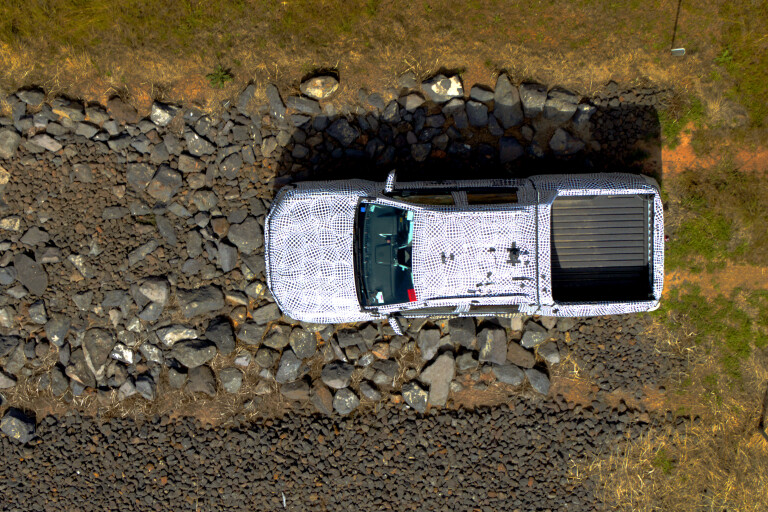
It will take some more time in the production vehicle to fully get to grips with this system and how much control the driver has over it, but with Mud/Ruts selected the Ranger prototype automatically selected low range and was ready to go. An off-road screen can be selected on the huge centre stack monitor which shows all the settings and the view from the off-road cameras and allows you to select them on the touchscreen.
In low range the V6 diesel engine crawled the new Ranger along smoothly at low revs and climbed the first mound with ease. You want to use less throttle in this car and let the torque of the V6 engine do the work. We didn’t know the specs at the time, but the V6 produces 600Nm compared to the four-cylinder bi-turbo’s 500Nm and it feels to be available from lower in the rev range, as you would expect of the bigger V6 engine. This V6 feels like it will be well-suited to towing and hauling loads.
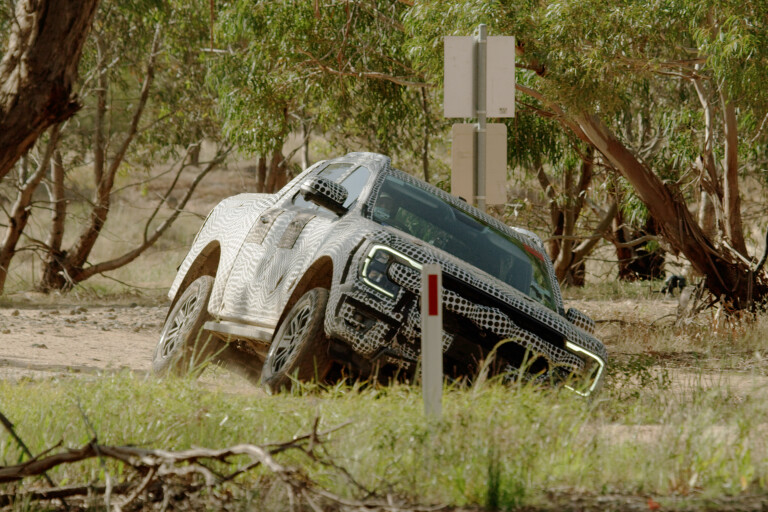
In contrast to the current model, the new one, with its 50mm-longer wheelbase, scraped its belly on the top of the mound and required a bit more speed to scrape across it without getting hung up.
The next obstacle was the cross-axle articulation, which the new prototype handled much easier than the current model thanks to its longer wheel travel and sharper traction-control calibration.
Climbing over the next rise gave the opportunity to make use of the forward-facing camera on the big screen. With a blind crest you couldn’t see which way the track went once over the top, but the screen gave clear indication of where to point the truck. The camera also showed a large rock off to one side of the track that was best avoided.

The longer and higher bonnet of the new model does block more of the driver’s view of the track ahead compared to that in the current model car. Forward-facing cameras help in this regard but are still no substitute for constant scanning and evaluating the track ahead of the car. I find that looking down at the centre screen requires you to stop the car while your eyes are off the track ahead, to ensure you don’t hit any surprises.
The following side-angle, rocky and sandy sections were covered without fuss, as the new Ranger didn’t slip a tyre. The improved stability afforded by the new car’s wider footprint and more compliant, longer travel suspension, gives the driver a more surefooted and confident feeling.

Both the on- and off-road loops we drove on the day were relatively short, but they each gave a strong insight into some of the conditions Ford Australia had been testing the next-gen Rangers under.
As we went through our exercises, countless other camouflaged Rangers could be seen and heard roaring around the high-speed loop circuit or screeching their tyres on a distant skid pan. Even at this late stage in the Ranger’s development, the testing went on relentlessly, here at You Yangs and other test sites around the world.
At one point late in the afternoon as we waited for the last of the drivers to complete their loop, a black and white camouflaged Ranger flew by on the high-speed loop, emitting a distinctly different sound to the others before it.
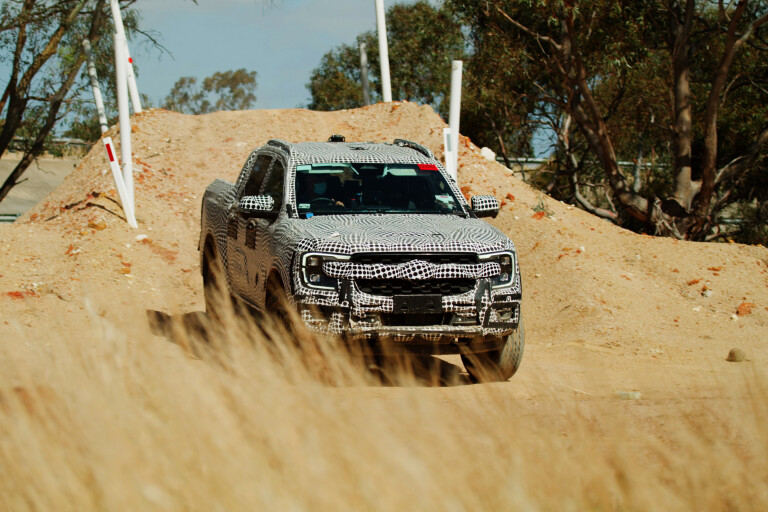
“That car sounded different to the others,” I said to Pritika Maharaj, who was standing beside me. It was more of a question than a statement, but the drivetrain expert wasn’t revealing anything, instead asking what I thought was different about it. I could only speculate at the time that it was a petrol engine and possibly the then-rumoured turbocharged V6 of the Ranger Raptor model. Pritika just smiled knowingly.
Of course, we now know that the Raptor version of the new Ranger will feature a turbocharged petrol V6 engine, which along with the V6 diesel we drove here, promises to make this next-gen Ranger the most exciting mid-size 4x4 ute to hit the market in a long time.



COMMENTS